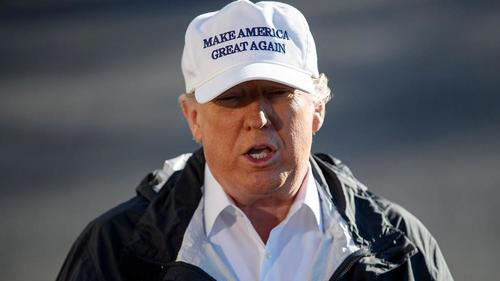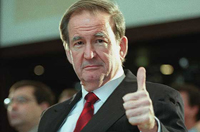At Age 70, Time To Rethink NATO
Patrick Buchanan

“Treaties are like roses and young girls. They last while they last.”
So said President Charles De Gaulle, who in 1966 ordered NATO to vacate its Paris headquarters and get out of France.
NATO this year celebrates a major birthday. The young girl of 1966 is no longer young. The alliance is 70 years old.
And under this aging NATO today, the U.S. is committed to treat an attack on any one of 28 nations from Estonia to Montenegro to Romania to Albania as an attack on the United States.
The time is ripe for a strategic review of these war guarantees to fight a nuclear-armed Russia in defense of countries across the length of Europe that few could find on a map.
Apparently, President Donald Trump, on trips to Europe, raised questions as to whether these war guarantees comport with vital U.S. interests and whether they could pass a rigorous cost-benefit analysis.
The shock of our establishment that Trump even raised this issue in front of Europeans suggests that the establishment, frozen in the realities of yesterday, ought to be made to justify these sweeping war guarantees.
Celebrated as “the most successful alliance in history,” NATO has had two histories. Some of us can yet recall its beginnings.
In 1948, Soviet troops, occupying eastern Germany all the way to the Elbe and surrounding Berlin, imposed a blockade on the city.
The regime in Prague was overthrown in a Communist coup. Foreign minister Jan Masaryk fell, or was thrown, from a third-story window to his death. In 1949, Stalin exploded an atomic bomb.
As the U.S. Army had gone home after V-E Day, the U.S. formed a new alliance to protect the crucial European powers — West Germany, France, Britain, Italy. Twelve nations agreed that an attack on one would be treated as an attack on them all.
Cross the Elbe and you are at war with us, including the U.S. with its nuclear arsenal, Stalin was, in effect, told. Hundreds of thousands of U.S. troops returned to Europe to send the message that America was serious.
Crucial to the alliance was the Yalta line dividing Europe agreed to by Stalin, FDR and Churchill at the 1945 Crimean summit on the Black Sea.
U.S. presidents, even when monstrous outrages were committed in Soviet-occupied Europe, did not cross this line into the Soviet sphere.
Truman did not send armored units up the highway to Berlin. He launched an airlift to break the Berlin blockade. Ike did not intervene to save the Hungarian rebels in 1956. JFK confined his rage at the building of the Berlin Wall to the rhetorical: “Ich bin ein Berliner.”
LBJ did nothing to help the Czechs when, before the Democratic convention in 1968, Leonid Brezhnev sent Warsaw Pact tank armies to crush the Prague Spring.
When the Solidarity movement of Lech Walesa was crushed in Gdansk, Reagan sent copy and printing machines. At the Berlin Wall in 1988, he called on Mikhail Gorbachev to “tear down this wall.”
Reagan never threatened to tear it down himself.
But beginning in 1989, the Wall was torn down, Germany was united, the Red Army went home, the Warsaw Pact dissolved, the USSR broke apart into 15 nations, and Leninism expired in its birthplace.
As the threat that had led to NATO disappeared, many argued that the alliance created to deal with that threat should be allowed to fade away, and a free and prosperous Europe should now provide for its own defense.
It was not to be. The architect of Cold War containment, Dr. George Kennan, warned that moving NATO into Eastern Europe and former Soviet republics would prove a “fateful error.”
This, said Kennan, would “inflame the nationalistic and militaristic tendencies in Russian opinion” and “restore the atmosphere of the cold war in East-West relations.” Kennan was proven right.
America is now burdened with the duty to defend Europe from the Atlantic to the Baltic, even as we face a far greater threat in China, with an economy and population 10 times that of Russia.
And we must do this with a defense budget that is not half the share of the federal budget or the GDP that Eisenhower and Kennedy had.
Trump is president today because the American people concluded that our foreign policy elite, with their endless interventions where no vital U.S. interest was imperiled, had bled and virtually bankrupted us, while kicking away all of the fruits of our Cold War victory.

Halfway into Trump’s term, the question is whether he is going to just talk about halting Cold War II with Russia, about demanding that Europe pay for its own defense, and about bringing the troops home — or whether he is going to act upon his convictions.
Our foreign policy establishment is determined to prevent Trump from carrying out his mandate. And if he means to carry out his agenda, he had best get on with it.

Patrick Buchanan has been a senior advisor to three Presidents, twice a candidate for the Republican presidential nomination, and the nominee of the Reform Party in 2000.
Born in Washington, D.C., Mr. Buchanan was educated at Gonzaga High School where he was graduated first in his class in 1956. He attended Georgetown on a full academic scholarship, and was graduated with honors in English and Philosophy in 1961, and inducted into the university’s Gold Key Society. He received a masters degree from the Graduate School of Journalism at Columbia in 1962. At 23, he became the youngest editorial writer on a major newspaper in America: The St. Louis Globe-Democrat.
After arranging a meeting with former Vice President Richard Nixon in December of 1965, Mr. Buchanan became the first full-time staffer in his legendary comeback. He traveled with the future President in the campaigns of 1966 and 1968, and to the Middle East, Africa and Israel in the immediate aftermath of the Six Day War. From January of 1969 to August of 1974, he was a Special Assistant to President Nixon, worked with the President on the Cambodian invasion speech, and with Vice President Agnew on many of his speeches on the media and student disorders. Mr. Buchanan was a member of the official US delegation to the Peoples Republic of China in 1972, and attended the Moscow-Yalta-Minsk summit of 1974. After President Nixon’s resignation, Mr. Buchanan served President Ford until October of 1974.
After leaving the White House, Mr. Buchanan became a nationally syndicated columnist, and in May of 1982 began as a panelist on NBC’s “The McLaughlin Group” and a co-host of CNN’s new show “Crossfire.”
In 1985, Mr. Buchanan returned to the White House as Director of Communications. He accompanied President Reagan to his Geneva summit with Mikhail Gorbachev and was with President Reagan in Hofde House at Reykjavik which has been described as the decisive summit of the Cold War. On leaving the White House in 1987, Mr. Buchanan returned to journalism, his syndicated column, and to “The McLaughlin Group,” “Crossfire,” and began hosting a new show, “Capital Gang” on CNN.
In December 1991, Mr. Buchanan challenged President George H. W. Bush for the Republican nomination and almost upset the President in New Hampshire, winning 3 million votes in the GOP primaries. In August 1992, Mr. Buchanan opened the Republican convention in Houston with his speech on the “culture war” which is now ranked among the most controversial in convention history. In 1996, he ran a second time for the GOP nomination, won the New Hampshire primary, and finished second to Sen. Dole, again, with three million Republican votes.
After winning the nomination of the Reform Party in 2000, Mr. Buchanan retired from politics and became again an author, columnist, and a commentator on MSNBC for almost a decade.
Mr. Buchanan has written 12 books, including seven straight New York Times bestsellers: A Republic, Not an Empire; The Death of the West; Where the Right Went Wrong, State of Emergency, Day of Reckoning, Churchill, Hitler and The Unnecessary War, and Suicide of a Superpower.
Mr. Buchanan is currently an author, columnist, chairman of The American Cause foundation, and an editor of The American Conservative. He is married to the former Shelley Ann Scarney, who was a member of the Richard Nixon’s vice presidential staff from 1959-61, and a member of the White House Staff from 1969 to 1975.
buchanan.org
| 



